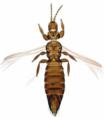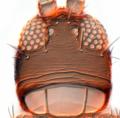Melanthrips digitus
Recognition data
Distinguishing features
Both sexes fully winged. Body legs and antennae brown to dark brown; fore wings fuscous with dark veins. Antennae 9-segmented; segments II–VIII with rows of microtrichia, VIII and IX equal in length, sensoria obliquely transverse on III–IV. Ocellar setae III arise on margins of ocellar triangle. Head with 3 pairs of prominent postocular setae. Pronotum posterior margin with 5 pairs of prominent setae, one pair of elongate posteroangular setae. Mesonotum with no microtrichia. Metanotum with elongate reticulation, no microtrichia, median setae small near posterior margin. Fore tibia inner apex produced into a process bearing a short apical seta. Tergite VIII median setae scarcely 0.3 as long as tergite; tergite X with paired trichobothria well developed. Sternite VII posterior margin with pair of lobes each bearing 2 setae at base.
Related and similar species
Currently there are 36 species listed in the genus Melanthrips. Most of these are from the Mediterranean region, but three are from India, two from South Africa, and two from southwestern USA. These two New World species are thus of considerable biogeographic interest. One of them, M. insulsus Bailey (1954), is based on a single female from Yucca flowers in Arizona. This specimen has not been studied, but females that are possibly this species have been studied from flowers of Nolina parryi (Agavaceae) from southern California. In contrast to M. digitus the fore wings are broad, and both species differ from all of the Old World species of Melanthrips in having the inner apex of the fore tibia produced into a short or long process bearing a short seta at its apex. Moreover, unlike the other species in the genus no microtrichia can be seen on either the mesonotum or metanotum of either species.
Taxonomic data
Current valid name
Melanthrips digitus Bailey
Original name and synonyms
- Melanthrips digitus Bailey, 1954: 79
Family placement
Melanthripidae
Biological data
Life history
The species of Melanthrips are all assumed to be phytophagous in flowers, and some of them seem to be host specific.
Host plants
Adenostoma sparsifolium (Rosaceae)
Tospoviruses vectored
None
Crop damage
None
Distribution data
Area of origin
Western USA
Distribution
California (San Diego and Riverside Counties)







